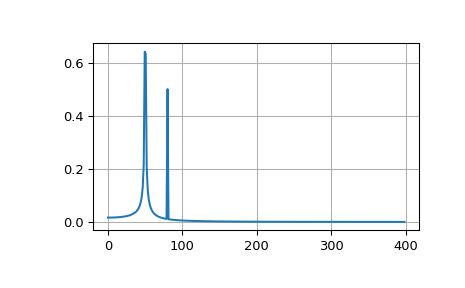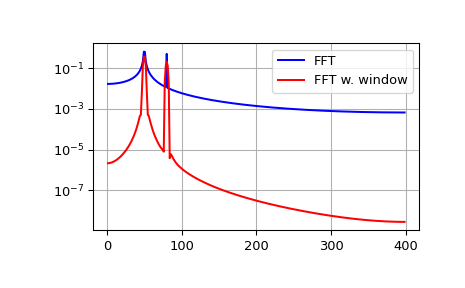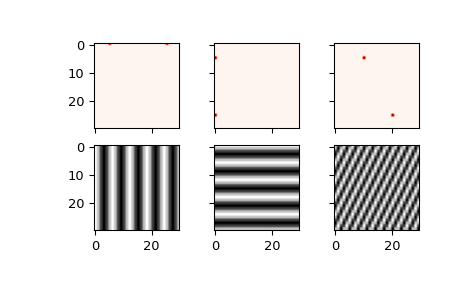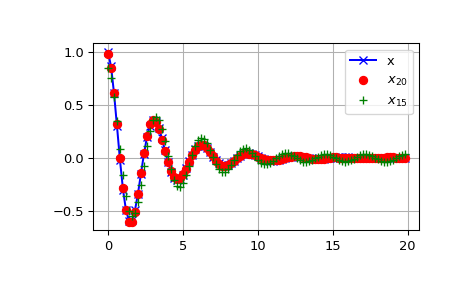傅里叶变换 (scipy.fft)#
傅里叶分析是一种将函数表示为周期分量之和,并从这些分量中恢复信号的方法。当函数及其傅里叶变换都替换为离散对应项时,称为离散傅里叶变换 (DFT)。DFT 已成为数值计算的主要内容之一,部分原因是存在一种非常快的计算算法,称为快速傅里叶变换 (FFT),该算法在高斯 (1805) 时就已知,并由 Cooley 和 Tukey [CT65] 以其当前形式呈现。Press 等人 [NR07] 提供了傅里叶分析及其应用的入门介绍。
快速傅里叶变换#
一维离散傅里叶变换#
长度为 \(N\) 的序列 x[n] 的 FFT y[k] 定义为
其逆变换定义如下
这些变换可以通过 fft 和 ifft 分别计算,如下例所示。
>>> from scipy.fft import fft, ifft
>>> import numpy as np
>>> x = np.array([1.0, 2.0, 1.0, -1.0, 1.5])
>>> y = fft(x)
>>> y
array([ 4.5 +0.j , 2.08155948-1.65109876j,
-1.83155948+1.60822041j, -1.83155948-1.60822041j,
2.08155948+1.65109876j])
>>> yinv = ifft(y)
>>> yinv
array([ 1.0+0.j, 2.0+0.j, 1.0+0.j, -1.0+0.j, 1.5+0.j])
从 FFT 的定义可以看出
在示例中
>>> np.sum(x)
4.5
这对应于 \(y[0]\)。对于偶数 N,元素 \(y[1]...y[N/2-1]\) 包含正频率项,而元素 \(y[N/2]...y[N-1]\) 包含负频率项,按负频率递减的顺序排列。对于奇数 N,元素 \(y[1]...y[(N-1)/2]\) 包含正频率项,而元素 \(y[(N+1)/2]...y[N-1]\) 包含负频率项,按负频率递减的顺序排列。
如果序列 x 是实值,则正频率对应的 \(y[n]\) 值是负频率对应的 \(y[n]\) 值的共轭(因为频谱是对称的)。通常,只绘制对应于正频率的 FFT。
该示例绘制了两个正弦波之和的 FFT。
>>> from scipy.fft import fft, fftfreq
>>> import numpy as np
>>> # Number of sample points
>>> N = 600
>>> # sample spacing
>>> T = 1.0 / 800.0
>>> x = np.linspace(0.0, N*T, N, endpoint=False)
>>> y = np.sin(50.0 * 2.0*np.pi*x) + 0.5*np.sin(80.0 * 2.0*np.pi*x)
>>> yf = fft(y)
>>> xf = fftfreq(N, T)[:N//2]
>>> import matplotlib.pyplot as plt
>>> plt.plot(xf, 2.0/N * np.abs(yf[0:N//2]))
>>> plt.grid()
>>> plt.show()

FFT 输入信号本质上是截断的。这种截断可以建模为无限信号与矩形窗函数的乘积。在频谱域中,这种乘积变为信号频谱与窗函数频谱的卷积,形式为 \(\sin(x)/x\)。这种卷积是导致频谱泄露(参见 [WPW])的原因。使用专用窗函数对信号进行加窗有助于减轻频谱泄露。下面的示例使用 scipy.signal 中的 Blackman 窗,并展示了加窗的效果(FFT 的零分量已被截断以作说明)。
>>> from scipy.fft import fft, fftfreq
>>> import numpy as np
>>> # Number of sample points
>>> N = 600
>>> # sample spacing
>>> T = 1.0 / 800.0
>>> x = np.linspace(0.0, N*T, N, endpoint=False)
>>> y = np.sin(50.0 * 2.0*np.pi*x) + 0.5*np.sin(80.0 * 2.0*np.pi*x)
>>> yf = fft(y)
>>> from scipy.signal.windows import blackman
>>> w = blackman(N)
>>> ywf = fft(y*w)
>>> xf = fftfreq(N, T)[:N//2]
>>> import matplotlib.pyplot as plt
>>> plt.semilogy(xf[1:N//2], 2.0/N * np.abs(yf[1:N//2]), '-b')
>>> plt.semilogy(xf[1:N//2], 2.0/N * np.abs(ywf[1:N//2]), '-r')
>>> plt.legend(['FFT', 'FFT w. window'])
>>> plt.grid()
>>> plt.show()

如果序列 x 是复值,则频谱不再对称。为了简化 FFT 函数的使用,scipy 提供了以下两个辅助函数。
函数 fftfreq 返回 FFT 采样频率点。
>>> from scipy.fft import fftfreq
>>> freq = fftfreq(8, 0.125)
>>> freq
array([ 0., 1., 2., 3., -4., -3., -2., -1.])
类似地,函数 fftshift 允许交换向量的上下半部分,使其适合显示。
>>> from scipy.fft import fftshift
>>> x = np.arange(8)
>>> fftshift(x)
array([4, 5, 6, 7, 0, 1, 2, 3])
下面的示例绘制了两个复指数的 FFT;请注意不对称频谱。
>>> from scipy.fft import fft, fftfreq, fftshift
>>> import numpy as np
>>> # number of signal points
>>> N = 400
>>> # sample spacing
>>> T = 1.0 / 800.0
>>> x = np.linspace(0.0, N*T, N, endpoint=False)
>>> y = np.exp(50.0 * 1.j * 2.0*np.pi*x) + 0.5*np.exp(-80.0 * 1.j * 2.0*np.pi*x)
>>> yf = fft(y)
>>> xf = fftfreq(N, T)
>>> xf = fftshift(xf)
>>> yplot = fftshift(yf)
>>> import matplotlib.pyplot as plt
>>> plt.plot(xf, 1.0/N * np.abs(yplot))
>>> plt.grid()
>>> plt.show()

函数 rfft 计算实序列的 FFT,并仅输出一半频率范围的复数 FFT 系数 \(y[n]\)。其余的负频率分量由实数输入的 FFT 的厄米对称性(y[n] = conj(y[-n]))暗示。如果 N 为偶数:\([Re(y[0]) + 0j, y[1], ..., Re(y[N/2]) + 0j]\);如果 N 为奇数:\([Re(y[0]) + 0j, y[1], ..., y[N/2]\)。明确显示为 \(Re(y[k]) + 0j\) 的项被限制为纯实数,因为根据厄米性质,它们是自身的复共轭。
相应的函数 irfft 计算具有这种特殊排序的 FFT 系数的 IFFT。
>>> from scipy.fft import fft, rfft, irfft
>>> x = np.array([1.0, 2.0, 1.0, -1.0, 1.5, 1.0])
>>> fft(x)
array([ 5.5 +0.j , 2.25-0.4330127j , -2.75-1.29903811j,
1.5 +0.j , -2.75+1.29903811j, 2.25+0.4330127j ])
>>> yr = rfft(x)
>>> yr
array([ 5.5 +0.j , 2.25-0.4330127j , -2.75-1.29903811j,
1.5 +0.j ])
>>> irfft(yr)
array([ 1. , 2. , 1. , -1. , 1.5, 1. ])
>>> x = np.array([1.0, 2.0, 1.0, -1.0, 1.5])
>>> fft(x)
array([ 4.5 +0.j , 2.08155948-1.65109876j,
-1.83155948+1.60822041j, -1.83155948-1.60822041j,
2.08155948+1.65109876j])
>>> yr = rfft(x)
>>> yr
array([ 4.5 +0.j , 2.08155948-1.65109876j,
-1.83155948+1.60822041j])
请注意,奇数和偶数长度信号的 rfft 具有相同的形状。默认情况下,irfft 假定输出信号应为偶数长度。因此,对于奇数信号,它会给出错误的结果
>>> irfft(yr)
array([ 1.70788987, 2.40843925, -0.37366961, 0.75734049])
要恢复原始的奇数长度信号,我们**必须**通过 n 参数传递输出形状。
>>> irfft(yr, n=len(x))
array([ 1. , 2. , 1. , -1. , 1.5])
二维和 N 维离散傅里叶变换#
函数 fft2 和 ifft2 分别提供二维 FFT 和 IFFT。类似地,fftn 和 ifftn 分别提供 N 维 FFT 和 IFFT。
对于实数输入信号,与 rfft 类似,我们有用于二维实数变换的函数 rfft2 和 irfft2;以及用于 N 维实数变换的 rfftn 和 irfftn。
下面的示例演示了二维 IFFT,并绘制了结果(二维)时域信号。
>>> from scipy.fft import ifftn
>>> import matplotlib.pyplot as plt
>>> import matplotlib.cm as cm
>>> import numpy as np
>>> N = 30
>>> f, ((ax1, ax2, ax3), (ax4, ax5, ax6)) = plt.subplots(2, 3, sharex='col', sharey='row')
>>> xf = np.zeros((N,N))
>>> xf[0, 5] = 1
>>> xf[0, N-5] = 1
>>> Z = ifftn(xf)
>>> ax1.imshow(xf, cmap=cm.Reds)
>>> ax4.imshow(np.real(Z), cmap=cm.gray)
>>> xf = np.zeros((N, N))
>>> xf[5, 0] = 1
>>> xf[N-5, 0] = 1
>>> Z = ifftn(xf)
>>> ax2.imshow(xf, cmap=cm.Reds)
>>> ax5.imshow(np.real(Z), cmap=cm.gray)
>>> xf = np.zeros((N, N))
>>> xf[5, 10] = 1
>>> xf[N-5, N-10] = 1
>>> Z = ifftn(xf)
>>> ax3.imshow(xf, cmap=cm.Reds)
>>> ax6.imshow(np.real(Z), cmap=cm.gray)
>>> plt.show()

离散余弦变换#
SciPy 提供了使用函数 dct 的 DCT 和使用函数 idct 的相应 IDCT。DCT 共有 8 种类型 [WPC], [Mak];但是,scipy 中仅实现了前 4 种类型。“DCT”通常指 DCT 类型 2,“逆 DCT”通常指 DCT 类型 3。此外,DCT 系数可以有不同的归一化方式(对于大多数类型,scipy 提供了 None 和 ortho)。dct/idct 函数调用的两个参数允许设置 DCT 类型和系数归一化。
对于一维数组 x,dct(x, norm=’ortho’) 等同于 MATLAB dct(x)。
DCT I 型#
SciPy 使用以下未归一化的 DCT-I 定义(norm=None)
请注意,DCT-I 仅支持输入大小大于 1 的情况。
DCT II 型#
SciPy 使用以下未归一化的 DCT-II 定义(norm=None)
在归一化 DCT(norm='ortho')的情况下,DCT 系数 \(y[k]\) 乘以一个比例因子 f
在这种情况下,DCT “基函数” \(\phi_k[n] = 2 f \cos \left({\pi(2n+1)k \over 2N} \right)\) 变为正交
DCT III 型#
SciPy 使用以下未归一化的 DCT-III 定义(norm=None)
或者,对于 norm='ortho'
DCT IV 型#
SciPy 使用以下未归一化的 DCT-IV 定义(norm=None)
或者,对于 norm='ortho'
DCT 和 IDCT#
(未归一化的)DCT-III 是(未归一化的)DCT-II 的逆,相差一个因子 2N。正交归一化的 DCT-III 恰好是正交归一化的 DCT-II 的逆。函数 idct 执行 DCT 和 IDCT 类型之间的映射,以及正确的归一化。
以下示例展示了不同类型和归一化方式下 DCT 和 IDCT 之间的关系。
>>> from scipy.fft import dct, idct
>>> x = np.array([1.0, 2.0, 1.0, -1.0, 1.5])
DCT-II 和 DCT-III 互为逆变换,因此对于正交变换,我们能回到原始信号。
>>> dct(dct(x, type=2, norm='ortho'), type=3, norm='ortho')
array([ 1. , 2. , 1. , -1. , 1.5])
然而,在默认归一化下执行相同的操作时,我们会得到一个额外的比例因子 \(2N=10\),因为正向变换未归一化。
>>> dct(dct(x, type=2), type=3)
array([ 10., 20., 10., -10., 15.])
因此,我们应该对两者使用相同类型的函数 idct,从而得到正确归一化的结果。
>>> # Normalized inverse: no scaling factor
>>> idct(dct(x, type=2), type=2)
array([ 1. , 2. , 1. , -1. , 1.5])
对于 DCT-I 也有类似结果,它是其自身的逆变换,相差一个因子 \(2(N-1)\)。
>>> dct(dct(x, type=1, norm='ortho'), type=1, norm='ortho')
array([ 1. , 2. , 1. , -1. , 1.5])
>>> # Unnormalized round-trip via DCT-I: scaling factor 2*(N-1) = 8
>>> dct(dct(x, type=1), type=1)
array([ 8. , 16., 8. , -8. , 12.])
>>> # Normalized inverse: no scaling factor
>>> idct(dct(x, type=1), type=1)
array([ 1. , 2. , 1. , -1. , 1.5])
对于 DCT-IV 也是如此,它也是其自身的逆变换,相差一个因子 \(2N\)。
>>> dct(dct(x, type=4, norm='ortho'), type=4, norm='ortho')
array([ 1. , 2. , 1. , -1. , 1.5])
>>> # Unnormalized round-trip via DCT-IV: scaling factor 2*N = 10
>>> dct(dct(x, type=4), type=4)
array([ 10., 20., 10., -10., 15.])
>>> # Normalized inverse: no scaling factor
>>> idct(dct(x, type=4), type=4)
array([ 1. , 2. , 1. , -1. , 1.5])
示例#
DCT 展现出“能量集中特性”,这意味着对于许多信号,只有前几个 DCT 系数具有显著的幅值。将其他系数归零会导致较小的重建误差,这一事实在有损信号压缩(例如 JPEG 压缩)中得到了利用。
下面的示例显示了信号 x 和从信号 DCT 系数重构的两个信号(\(x_{20}\) 和 \(x_{15}\))。信号 \(x_{20}\) 是由前 20 个 DCT 系数重构的,\(x_{15}\) 是由前 15 个 DCT 系数重构的。可以看出,使用 20 个系数的相对误差仍然非常小(约 0.1%),但提供了五倍的压缩率。
>>> from scipy.fft import dct, idct
>>> import matplotlib.pyplot as plt
>>> N = 100
>>> t = np.linspace(0,20,N, endpoint=False)
>>> x = np.exp(-t/3)*np.cos(2*t)
>>> y = dct(x, norm='ortho')
>>> window = np.zeros(N)
>>> window[:20] = 1
>>> yr = idct(y*window, norm='ortho')
>>> sum(abs(x-yr)**2) / sum(abs(x)**2)
0.0009872817275276098
>>> plt.plot(t, x, '-bx')
>>> plt.plot(t, yr, 'ro')
>>> window = np.zeros(N)
>>> window[:15] = 1
>>> yr = idct(y*window, norm='ortho')
>>> sum(abs(x-yr)**2) / sum(abs(x)**2)
0.06196643004256714
>>> plt.plot(t, yr, 'g+')
>>> plt.legend(['x', '$x_{20}$', '$x_{15}$'])
>>> plt.grid()
>>> plt.show()

离散正弦变换#
SciPy 提供了使用函数 [Mak] 的 DST dst 和使用函数 idst 的相应 IDST。
理论上,DST 有 8 种类型,对应于偶/奇边界条件和边界偏移的不同组合 [WPS],但 scipy 中仅实现了前 4 种类型。
DST I 型#
DST-I 假设输入在 n=-1 和 n=N 处为奇对称。SciPy 使用以下未归一化的 DST-I 定义(norm=None)
另请注意,DST-I 仅支持输入大小大于 1 的情况。(未归一化的)DST-I 是其自身的逆变换,相差一个因子 2(N+1)。
DST II 型#
DST-II 假设输入在 n=-1/2 处为奇对称,在 n=N 处为偶对称。SciPy 使用以下未归一化的 DST-II 定义(norm=None)
DST III 型#
DST-III 假设输入在 n=-1 处为奇对称,在 n=N-1 处为偶对称。SciPy 使用以下未归一化的 DST-III 定义(norm=None)
DST IV 型#
SciPy 使用以下未归一化的 DST-IV 定义(norm=None)
或者,对于 norm='ortho'
DST 和 IDST#
以下示例展示了不同类型和归一化方式下 DST 和 IDST 之间的关系。
>>> from scipy.fft import dst, idst
>>> x = np.array([1.0, 2.0, 1.0, -1.0, 1.5])
DST-II 和 DST-III 互为逆变换,因此对于正交变换,我们能回到原始信号。
>>> dst(dst(x, type=2, norm='ortho'), type=3, norm='ortho')
array([ 1. , 2. , 1. , -1. , 1.5])
然而,在默认归一化下执行相同的操作时,我们会得到一个额外的比例因子 \(2N=10\),因为正向变换未归一化。
>>> dst(dst(x, type=2), type=3)
array([ 10., 20., 10., -10., 15.])
因此,我们应该对两者使用相同类型的函数 idst,从而得到正确归一化的结果。
>>> idst(dst(x, type=2), type=2)
array([ 1. , 2. , 1. , -1. , 1.5])
对于 DST-I 也有类似结果,它是其自身的逆变换,相差一个因子 \(2(N-1)\)。
>>> dst(dst(x, type=1, norm='ortho'), type=1, norm='ortho')
array([ 1. , 2. , 1. , -1. , 1.5])
>>> # scaling factor 2*(N+1) = 12
>>> dst(dst(x, type=1), type=1)
array([ 12., 24., 12., -12., 18.])
>>> # no scaling factor
>>> idst(dst(x, type=1), type=1)
array([ 1. , 2. , 1. , -1. , 1.5])
对于 DST-IV 也是如此,它也是其自身的逆变换,相差一个因子 \(2N\)。
>>> dst(dst(x, type=4, norm='ortho'), type=4, norm='ortho')
array([ 1. , 2. , 1. , -1. , 1.5])
>>> # scaling factor 2*N = 10
>>> dst(dst(x, type=4), type=4)
array([ 10., 20., 10., -10., 15.])
>>> # no scaling factor
>>> idst(dst(x, type=4), type=4)
array([ 1. , 2. , 1. , -1. , 1.5])
快速汉克尔变换#
SciPy 提供了函数 fht 和 ifht,用于对对数间隔的输入数组执行快速汉克尔变换 (FHT) 及其逆变换 (IFHT)。
FHT 是由 [Ham00] 定义的连续汉克尔变换的离散化版本
其中 \(J_{\mu}\) 是 \(\mu\) 阶贝塞尔函数。在变量变换 \(r \to \log r\), \(k \to \log k\) 下,这变为
这在对数空间中是一个卷积。FHT 算法使用 FFT 对离散输入数据执行此卷积。
必须注意尽量减少由于 FFT 卷积的循环性质引起的数值振铃。为了确保满足低振铃条件 [Ham00],可以使用 fhtoffset 函数计算的偏移量来稍微移动输出数组。
参考文献#
Cooley, James W., and John W. Tukey, 1965, “复数傅里叶级数机器计算算法,” Math. Comput. 19: 297-301.
Press, W., Teukolsky, S., Vetterline, W.T., and Flannery, B.P., 2007, 数值食谱:科学计算的艺术, ch. 12-13. Cambridge Univ. Press, Cambridge, UK.
J. Makhoul, 1980, ‘一维和二维快速余弦变换’, IEEE Transactions on acoustics, speech and signal processing vol. 28(1), pp. 27-34, DOI:10.1109/TASSP.1980.1163351
A. J. S. Hamilton, 2000, “非线性功率谱的非相关模式”, MNRAS, 312, 257. DOI:10.1046/j.1365-8711.2000.03071.x